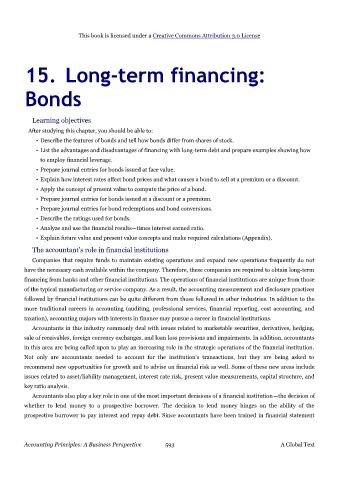Page 592 - Accounting Principles (A Business Perspective)
P. 592
This book is licensed under a Creative Commons Attribution 3.0 License
15. Long-term financing:
Bonds
Learning objectives
After studying this chapter, you should be able to:
• Describe the features of bonds and tell how bonds differ from shares of stock.
• List the advantages and disadvantages of financing with long-term debt and prepare examples showing how
to employ financial leverage.
• Prepare journal entries for bonds issued at face value.
• Explain how interest rates affect bond prices and what causes a bond to sell at a premium or a discount.
• Apply the concept of present value to compute the price of a bond.
• Prepare journal entries for bonds issued at a discount or a premium.
• Prepare journal entries for bond redemptions and bond conversions.
• Describe the ratings used for bonds.
• Analyze and use the financial results—times interest earned ratio.
• Explain future value and present value concepts and make required calculations (Appendix).
The accountant's role in financial institutions
Companies that require funds to maintain existing operations and expand new operations frequently do not
have the necessary cash available within the company. Therefore, these companies are required to obtain long-term
financing from banks and other financial institutions. The operations of financial institutions are unique from those
of the typical manufacturing or service company. As a result, the accounting measurement and disclosure practices
followed by financial institutions can be quite different from those followed in other industries. In addition to the
more traditional careers in accounting (auditing, professional services, financial reporting, cost accounting, and
taxation), accounting majors with interests in finance may pursue a career in financial institutions.
Accountants in this industry commonly deal with issues related to marketable securities, derivatives, hedging,
sale of receivables, foreign currency exchanges, and loan loss provisions and impairments. In addition, accountants
in this area are being called upon to play an increasing role in the strategic operations of the financial institution.
Not only are accountants needed to account for the institution's transactions, but they are being asked to
recommend new opportunities for growth and to advise on financial risk as well. Some of these new areas include
issues related to asset/liability management, interest rate risk, present value measurements, capital structure, and
key ratio analysis.
Accountants also play a key role in one of the most important decisions of a financial institution—the decision of
whether to lend money to a prospective borrower. The decision to lend money hinges on the ability of the
prospective borrower to pay interest and repay debt. Since accountants have been trained in financial statement
Accounting Principles: A Business Perspective 593 A Global Text

